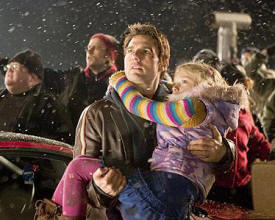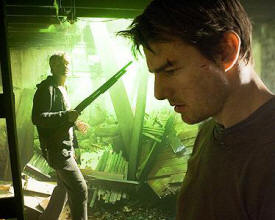Making movies. Enjoying movies. Remembering movies.
Related Articles:
|
By
Rick Mitchell

It takes a real master to show up the
pretenders to his title. Just as George Romero's "Land Of The Dead"
blows away all the recent zombie films, Steven Spielberg's version of
"War Of The Worlds" shows how a real "movie-movie" ought to be done.
I'd had trepidations about this as, ever since Spielberg seems to have
decided he wanted to be viewed as a "respectable" filmmaker in the eyes
of the East Coast critical establishment, his enthusiasm for the type of
film that made him seemed to have waned. Both his "Jurassic Park" films
and even "Minority Report" had a by-the-numbers feel, but his more
"serious" works like "Schindler's List," "A.I.," and especially
"Amistad" also have a schizophrenic quality suggesting he was trying too
hard to escape his past.
The opening sequences of "War Of The Worlds" suggest this same problem,
but once the aliens manifest themselves, there is a welcome renaissance
of the Spielberg of "Jaws" and the Indiana Jones films, an extremely
intense compact 75 minutes of pure cinematic suspense and spectacle that
lets up only slightly for the film's final 20 minutes. What makes it
work is that unlike in most recent films of this sort which are shot and
edited in such a confusing manner that most of the time you're lost as
to what's happening and whose doing what to whom, though the film is
shot 1.85:1 (Spielberg has acknowledged that his vision has narrowed
with age), he and cinematographer Janusz Kaminski have shot largely with
wide angle lenses with Spielberg's patented close to wide moves, all
which enhance your involvement with the on-screen events.
 |
|
Tom Cruise And Dakota Fanning |
Further enhancing this is the sound
(which is LOUD, for those who have a problem with that). Unlike the
"noise for noise sake" in so many contemporary action films, here it is
organic to the film, the use of stereo helping to pull you into the
picture. Sound designer Richard King and his team and re-recording
mixers Andy Nelson and Anna Behlmer should have a lock on those Oscars.
More importantly, unlike the seemly animated cartoon inspired CGI shots
in most of today's action films, which further enhances their obvious
phoniness, Spielberg and Co. stick with setups for the effects shots
that logically look like they were photographed with a camera on the
scene. This is true of even what is probably the most spectacular shot
in the film, a long single take simulating a remote head doing two or
three 360s in, out, and around an SUV being driven by Tom Cruise through
a mob of people fleeing up a turnpike.
Where the film is a bit of a letdown is in its "book" portion. Spielberg
goes back to H.G. Wells' original concept of viewing the events through
the eyes of an ordinary person, something that George Pal was not
allowed to do by Paramount's then head of production, Don Hartman, a
former comedy writer, according to Cinefantastique's retrospect on the
1953 version published in the late Seventies. As is typical with him,
Spielberg has chosen to make his hero a New Jersey dock worker with a
dysfunctional family. There is a bit too much of this and it gets
redundant, particularly when juxtaposed against the larger events; at
one point a disagreement between Cruise and his teenage son is stretched
almost to the point of laughable absurdity because of the context of its
occurrence.
Tom Cruise's recent antics may obscure the quality of his performance.
In the early part of the film, Spielberg cuts to close ups of him or
shots with him in them for reactions to the events that some may quibble
with, but by the middle of the film, one finds oneself searching the
crowds for him and his family to see how they're being affected now. I
was never down on Cruise as many were before he became "respectable"
around the time of "Jerry Maguire," and though he still looks too young
to have a 16-year-old son, like Denzel Washington, he is a very
cinematic re-actor, one who knows how to use his body language, face,
and especially his eyes to convey what his character is feeling with a
subtlety that in film has a far greater impact on audiences than any
degree of "War And Peace"-length pages of dialog or Methodical scenery
mastication.
 |
|
Tim Robbins And Tom Cruise |
Of the other actors, Dakota Fanning is
okay as long as she isn't screaming; unfortunately there's too much of
that though not quite to the point of making you wish the aliens would
silence her. There is a one-noteness to the anger of the kid who plays
Cruise's son that would be less grating if the reason for it was
explained better; it appears to not just be adolescent rebellion against
his father. In fact, there is a suggestion that his sensibilities might
be closer to those of the character overplayed by Tim Robbins, which
tends to veer away from natural into scenery chewing, though not
overtly.
There are a few other flaws that strike you when reflecting back on the
film. The first alien attack seems to occur within walking distance of
Cruise's home yet his kids appear to have heard nothing when he gets
back to them. The alien tripods have the usual problem with seemingly
very heavy subjects rendered in CGI: the sinuous undulations of the legs
still make them look like they're floating in a gravity defying manner
despite their apparent bulk. Spielberg's decision to not include any
kind of voice from science, which Wells also had, also leaves some
unanswered questions, especially since it's implied that the Cruise
character seems to have a better idea of what's happening than the other
characters. Making him an amateur astronomer or a science-fiction
hobbyist, which would be credible even for a New Jersey dockworker
today, would have helped sand over some of these story holes.
There are obvious homages to the Pal film, especially toward the end,
and Spielberg even manages to work in his fascination with trains in a
particularly spectacular manner.
All this aside, "War Of The Worlds" holds its own with both the Pal film
and the controversial "Independence Day." If you want a true cinematic
experience, it is well worth the time, trouble, and expense of seeing in
a theater, especially one with a big screen and good sound system.
Keep watching the screen.
Rick Mitchell is a film editor, film director, and film historian. He lives in Los Angeles.
© 2005 Rick Mitchell. All rights reserved
IMAGES © DreamWorks, Paramount Pictures. All rights reserved
